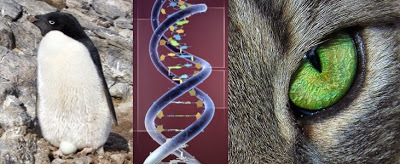What Makes a Cat a Cat? It’s All in the Genes
Miss Cuddlywumps reports on new research into the domestic cat genome
 What makes a cat a cat and not a penguin? The DNA.Illustration by Chocahuète + fichiers commons [GFDL or CC-BY-SA-3.0-2.5-2.0-1.0], via Wikimedia Commons.You are picturing the product of the information contained within the cat’s genes. In that genome, some researchers at Washington University School of Medicine in St. Louis have recently found some interesting things, including evidence of feline domestication and of what sets cats apart from other mammals.
What makes a cat a cat and not a penguin? The DNA.Illustration by Chocahuète + fichiers commons [GFDL or CC-BY-SA-3.0-2.5-2.0-1.0], via Wikimedia Commons.You are picturing the product of the information contained within the cat’s genes. In that genome, some researchers at Washington University School of Medicine in St. Louis have recently found some interesting things, including evidence of feline domestication and of what sets cats apart from other mammals. DNA evidence of (semi-) domesticationCats and humans have been together for “only” 9,000 years or so (compared to the 30,000 or more years since domestic dogs arose from wolves).
Cats, though, “are really only semidomesticated,” according to genetics professor Wes Warren, who was involved in the research. “They only recently split off from wild cats, and some even still breed with their wild relatives. So we were surprised to find DNA evidence of their domestication.”
The researchers compared genomes of domestic and wild cats and found areas where changes have happened apparently as a result of domestication. Changes were found in genes thought to be involved in memory, fear, and reward-seeking, all of which could be important in domestication.
For example, cats might have started hanging around human settlements because of the food (rodents) they found there, and humans might have encouraged them to stay by offering rewards of more food. (And you all know how a cat will hang around once you’ve given it food. That’s how She of Little Talent got one of her real cats, Jack, a former stray who kept hanging around the bird feeder. Now he’s semidomesticated and enjoys crunchy treats and soft blankies.)
As the theory goes, the less fearful cats would hang around more, getting more food rewards and having kittens who learned from a young age to hang around humans and not be terrified of them, until eventually there arose a type of cat whose genome was slightly different from its wild ancestors’.
The Birman’s white glovesThe researchers studied the genomes of some purebred cats, including the Birman. They found that the Birman’s characteristic white paws are linked to two small changes in one gene for hair color. All Birmans have this genetic signature, which could be evidence that humans bred the cats specifically for their adorable little white paws.
 A Birman cat. Note the adorable white paws,a trait related to two small changes on a single gene.Photo by sk_catz [CC-BY-SA-3.0], via Wikimedia Commons.
A Birman cat. Note the adorable white paws,a trait related to two small changes on a single gene.Photo by sk_catz [CC-BY-SA-3.0], via Wikimedia Commons.Cats and tigers have special genes for breaking down fats. This helps the cats, big and small, digest their fatty, all-meat meals.Cats don’t have as many genes for smell as dogs do. They don’t need as many because their hunting technique relies less on scent than on vision and hearing. However, cats have more genes that help them detect pheromones, which help them find mates and keep track of what other cats in the vicinity are up to.Cats have genes that allow them to hear across a greater range than other carnivores (into the ultrasonic range) to help them track prey.Cats have genes for improved low-light vision, important for a hunter on the prowl at dawn and dusk.
The research was published Nov. 10 in the Proceedings of the National Academy of Sciences Early Edition.SourceWashington University in St. Louis.
For more on cat DNA, see “Clues to Cat History Written in DNA” and “Where Purebred Cats Come From”
Published on November 14, 2014 02:00
No comments have been added yet.
Roby Sweet's Blog
- Roby Sweet's profile
- 7 followers
Roby Sweet isn't a Goodreads Author
(yet),
but they
do have a blog,
so here are some recent posts imported from
their feed.



